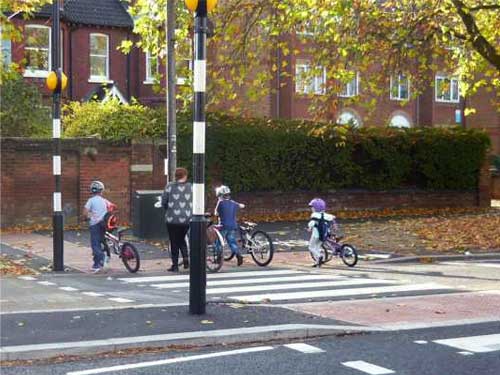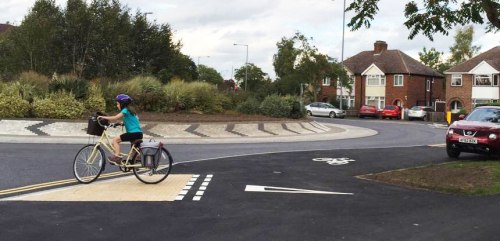It’s difficult to know where to start when writing about the Bedford turbo-roundabout and everything that surrounds it. The whole scandal – and it does deserve that word – goes well beyond that one scheme, extends through the cycle campaign industry, right up to the government.
At one end of the scale, the finished Bedford turbo-roundabout has been scrutinised and has come up sorely lacking, and clearly falls into the “farcility” category that the CTC is apparently so keen to reject.
For a full picture of what we got for our £490,000 you can read this PDF report written by John Meudell (former CTC National Council member for the South East) and Graham Smith (who now holds that same role). It contains lots of photographs, so you can see for yourself how poor it really is.
Suffice to say, it’s not a glowing report: “Arrangement of cycle crossings maximises possibility of conflict between cyclist and pedestrian” … “Elimination of raised lane divider does not deter lane changing, undermining safety benefits” … “Cyclist trapped onto transition kerb” … “Incompetent!”

Remember, this is from a design approved by Sustrans, Cyclenation, British Cycling and CTC. It looks like the worst kind of “fiddly pavement conversion” to me.
The hype around this dreadful scheme is so intense that Patrick Lingwood was nominated for a “Smarter Travel Professional of the Year” award, which makes me truly despair, as one of the boasts of this so-called cycling scheme is that it has made journeys by motor vehicle much more convenient.
Lingwood is also giving talks about how great it is, as is Alasdair Massie who is proud of a similarly poor design on Perne Road in Cambridge (see here, here and here for more about Massie’s folly).
The level of delusion is massive. At 20 minutes 45 seconds into the presentation, Lingwood excitedly speaks of “children cycling across a very busy road” while the photo clearly shows a family who have dismounted and are walking across the road. Is this wilful blindness or blatant lying?

“Children cycling across a very busy road” says Lingwood. Surely walking with a bike doesn’t count as cycling? Also, the central waiting area looks narrow to me. (Source: this PDF)
So nearly half a million pounds of public money intended for cycling was spent on a design where people feel it’s necessary to stop cycling in order to use it, but the man responsible considers this a success. Great work there, Pat. Nice emperor’s new clothes you’re wearing.
(As an aside, Lingwood also reveals that what gave the Motorcycle Action Group so much clout was that they have “friends in high places” – I assume this means that MAG head and former MP Lembit Opik was friendly with his fellow Lib Dems in governmental transport roles, and called in a favour.)
The bigger picture
But then at the other end of the scale, there’s the questionable way in which the Department for Transport funded this scheme. Why does cycling infrastructure receive such small amounts of occasional investment? Why are such tight timescales placed on these projects? Why was the money given to a charity to distribute, which then passed responsibility to an unaccountable group of individuals who rubber-stamped such poor designs?
Does the DfT fund motorways in this manner?
The Bedford turbo isn’t the only dubious project that was funded as part of this programme. Highlights include:
- the Itchen/Central Bridge junction in Southampton which didn’t even manage a fortnight without claiming its first victim
- the Richmond Hill roundabout in Bournemouth with its ‘innovative’ use of painted lanes and stop boxes
- the Park Road/Burghley Square roundabout in Peterborough shown here after having £160,000 of Cycle Safety Fund money spent on it
- as mentioned earlier, the atrocious Perne Road roundabout designed by Lingwood’s frequent co-presenter Alasdair Massie, which also claimed its first victim within days of opening

Perne Road roundabout in Cambridge. £360,000 was wasted on this project, an incompetent design by Alasdair Massie, who was warned of the dangers years before. (Photo: Chris Rand)
I don’t have time to go through all of them, but were there any – with the possible exception of the short length of cycleway on Baldwin Street in Bristol – which could be considered money well spent?
But with such a ridiculous funding model – limited funds, short timescales, etc. – perhaps failure was built-in from the start. I can understand the view that that CTC, Cyclenation and co. were right to make the best of a bad situation, but I still feel it would be best to reject these hopeless crumbs outright. Getting involved with such dubious projects lends them a legitimacy they don’t deserve, and gives the campaigns a reputation for approving rubbish.
It seems that the whole episode is a good example of Britain’s failure to treat cycling as a proper mode of transport, and of how the major cycling campaigns are complicit in this cycle.
Every year or so, the DfT finds some loose change down the back of the sofa and throws it at the craven cycling lobby who then write a press release about what a great step forward it is and how the government is finally starting to take cycling seriously. Cycle campaigners are then sated for another year, until they’re given some more crumbs to shut them up again.
It’s the same story, time and time again. Crap is built, excuses are made, then a year or two later more crumbs are announced under a new name, and we all rinse and repeat.








 The Alternative Department for Transport is written by, and the personal opinion of,
The Alternative Department for Transport is written by, and the personal opinion of, 


